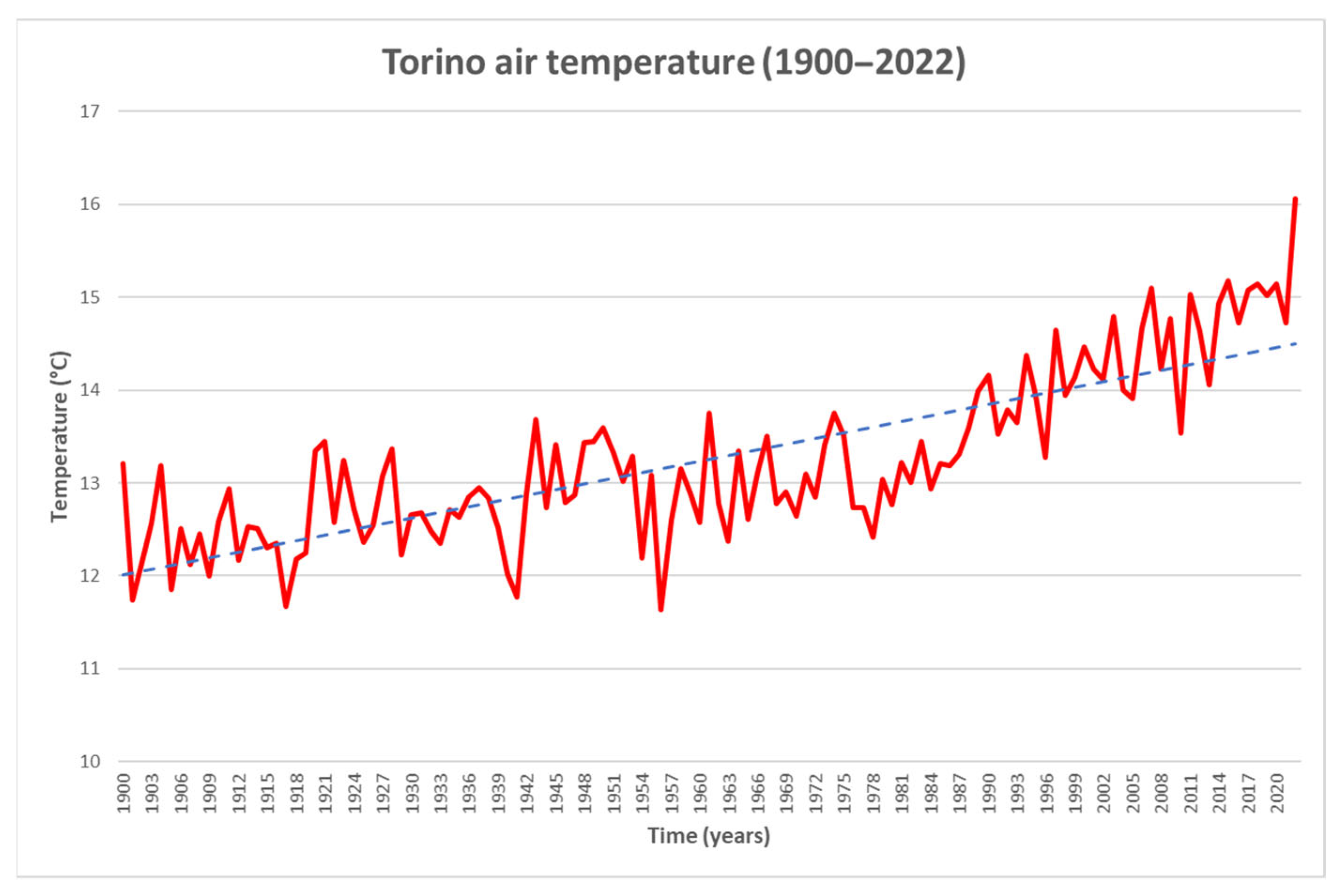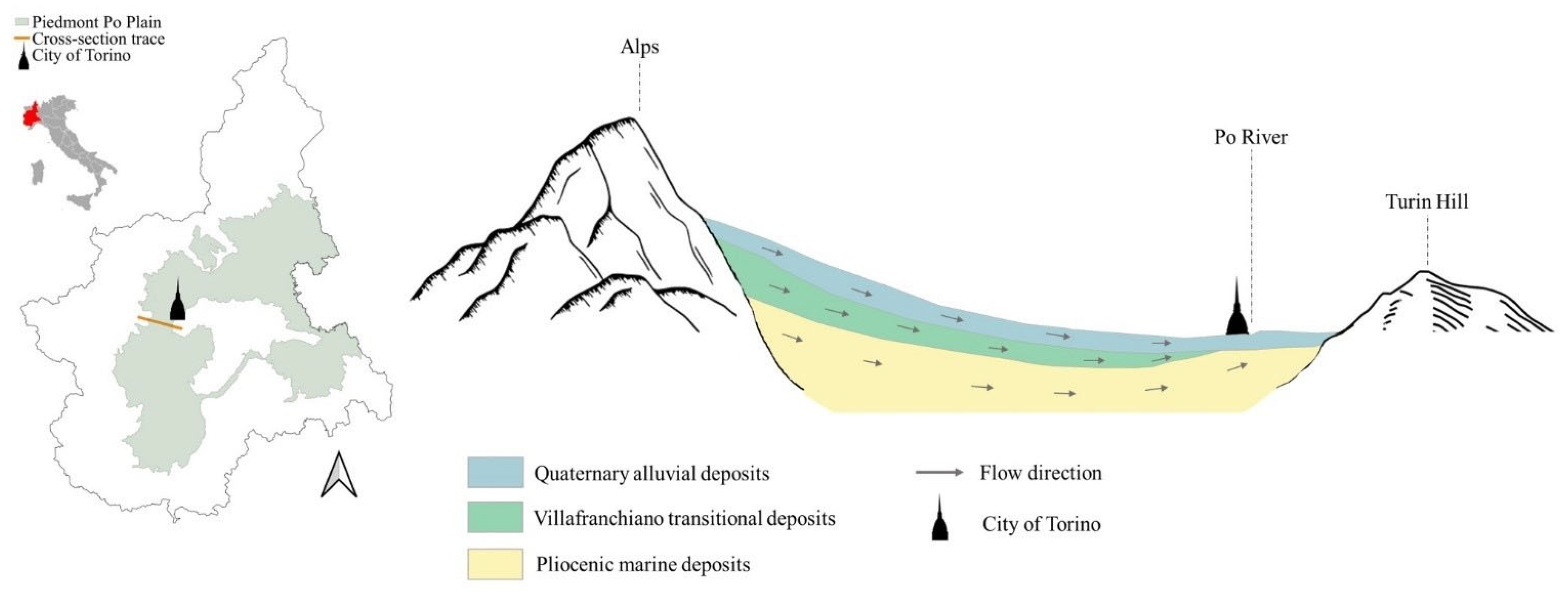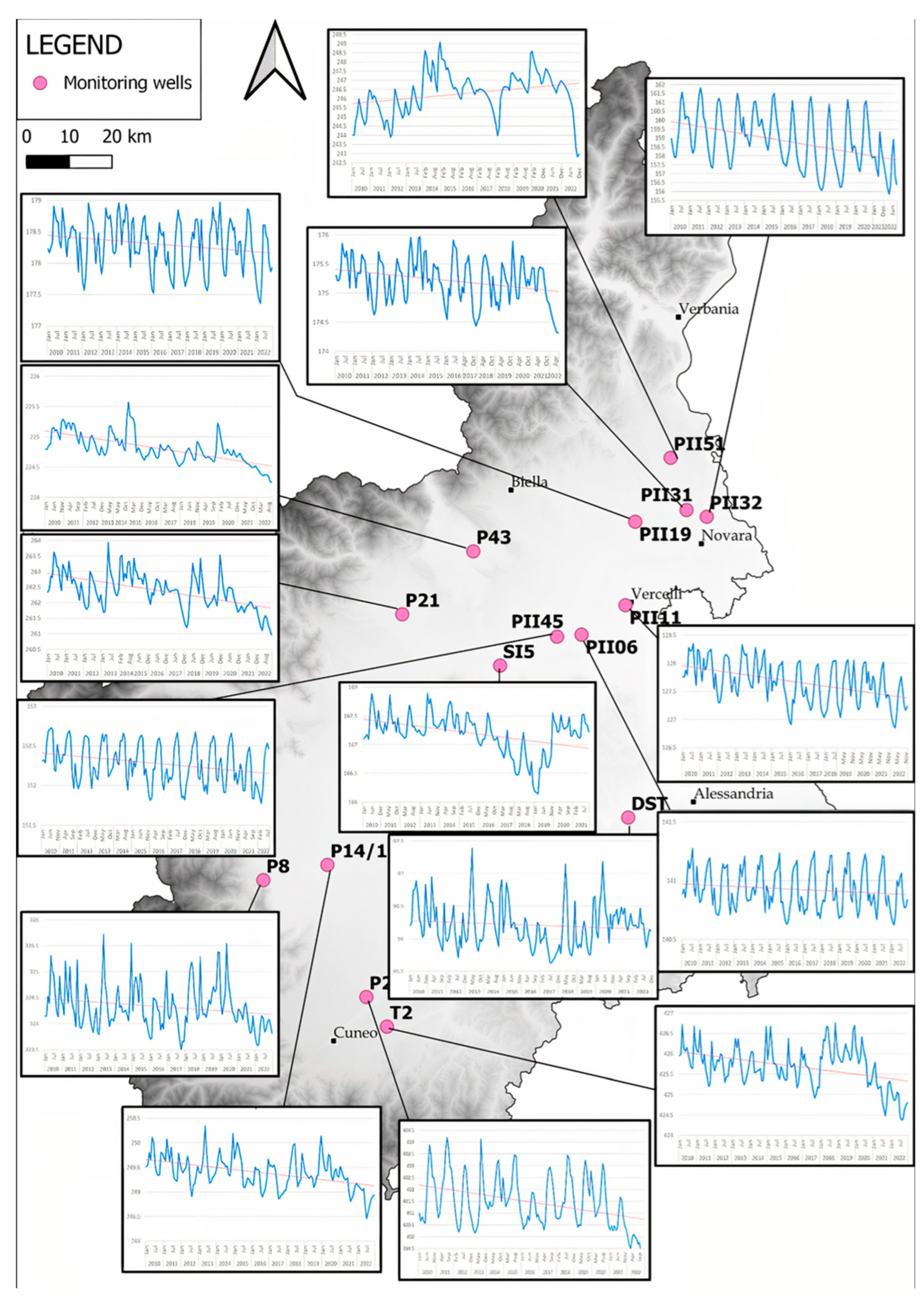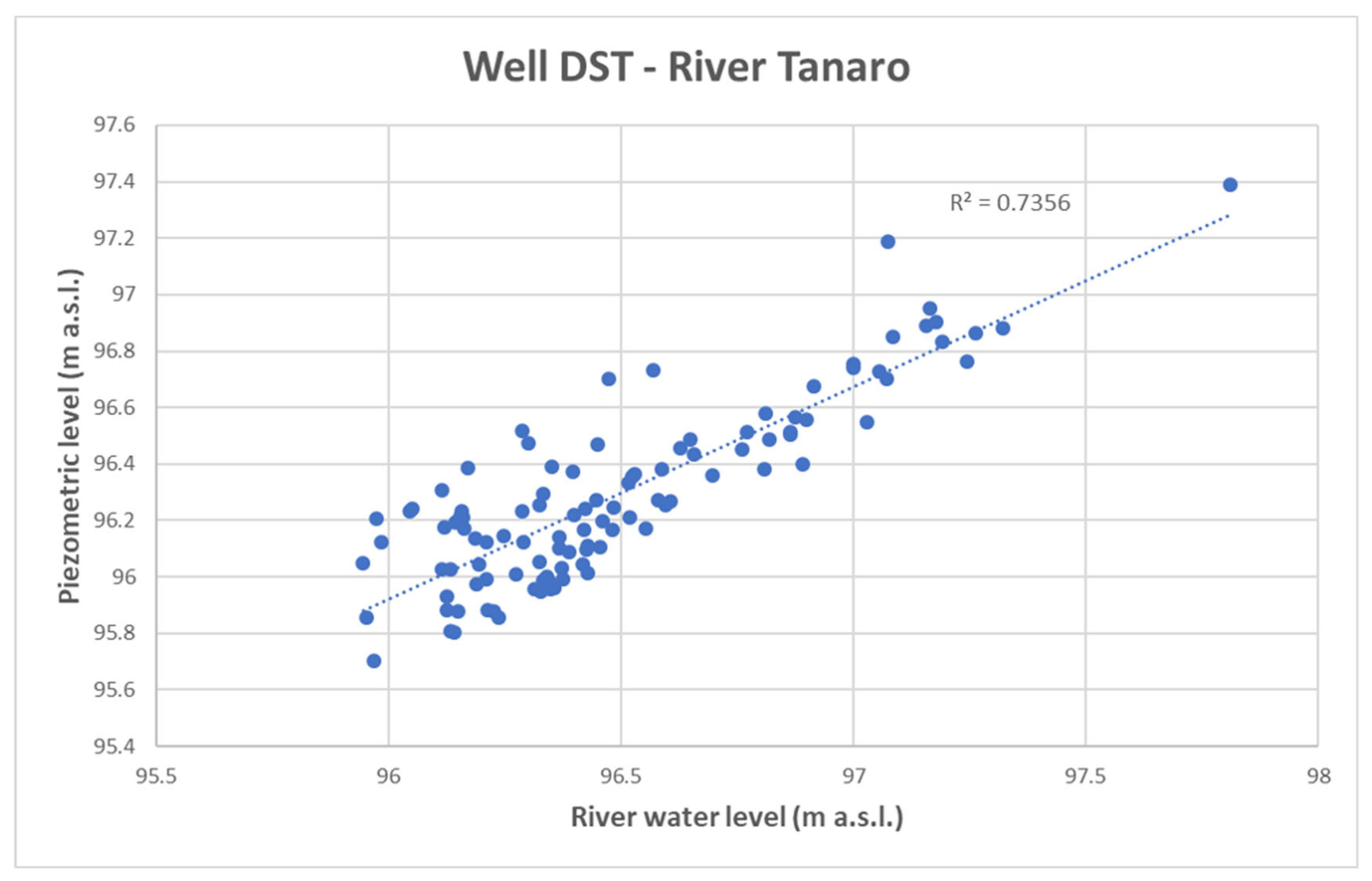Spatio–Temporal Dynamics of Groundwater Levels in the Piedmont Po Plain (NW Italy): Impacts of Climate Change and Land Use
Abstract
1. Introduction
2. Study Area
2.1. Climatic Setting
2.2. Hydrogeological Setting
- -
- Quaternary alluvial deposits (lower Pleistocene–Holocene), that host a shallow unconfined aquifer. Formed by fluvial deposits due to the erosion and sedimentation processes of rivers, including the Po and its tributaries, and by fluvioglacial deposits, this complex consists mainly of gravel and sand. Alluvial deposits are prevalent in the low-lying areas of the plain and contribute to its fertile soils;
- -
- Villafranchiano transitional deposits (late Pliocen–early Pleistocene), which host a multi-layered aquifer. They are predominantly lacustrine, swamp and fluvial sediments and consist of both permeable deposits (pebble, gravel, sand) and low-permeability deposits (silt and clay);
- -
- Pliocenic marine deposits (Pliocene), hosting a confined aquifer. Predominantly found in the southern and western margins of the plain, marine deposits originate from ancient seas that once covered the area. These deposits comprise layers of sand, silt, and clay, reflecting past marine environments. Marine deposits may contain valuable fossil records.
3. Materials and Methods
4. Results
- -
- DST does not show a statistically significant trend;
- -
- PII51 shows a positive statistical trend.
5. Discussion
6. Conclusions
Author Contributions
Funding
Data Availability Statement
Conflicts of Interest
References
- Wu, W.-Y.; Lo, M.-H.; Wada, Y.; Famiglietti, J.S.; Reager, J.T.; Yeh, P.J.-F.; Ducharne, A.; Yang, Z.-L. Divergent Effects of Climate Change on Future Groundwater Availability in Key Mid-Latitude Aquifers. Nat. Commun. 2020, 11, 3710. [Google Scholar] [CrossRef] [PubMed]
- Mc, M. Climate Change Impacts on Groundwater: Literature Review. Environ. Risk Assess. Remediat. 2018, 2. [Google Scholar] [CrossRef]
- Lall, U.; Josset, L.; Russo, T. A Snapshot of the World’s Groundwater Challenges. Annu. Rev. Environ. Resour. 2020, 45, 171–194. [Google Scholar] [CrossRef]
- Wang, H.; Gao, J.; Li, X.; Wang, H.; Zhang, Y. Effects of Soil and Water Conservation Measures on Groundwater Levels and Recharge. Water 2014, 6, 3783–3806. [Google Scholar] [CrossRef]
- Earman, S.; Dettinger, M. Potential Impacts of Climate Change on Groundwater Resources—A Global Review. J. Water Clim. Change 2011, 2, 213–229. [Google Scholar] [CrossRef]
- Stigter, T.Y.; Miller, J.; Chen, J.; Re, V. Groundwater and Climate Change: Threats and Opportunities. Hydrogeol. J. 2023, 31, 7–10. [Google Scholar] [CrossRef]
- Holman, I.P. Climate Change Impacts on Groundwater Recharge-Uncertainty, Shortcomings, and the Way Forward? Hydrogeol. J. 2006, 14, 637–647. [Google Scholar] [CrossRef]
- Dragoni, W.; Sukhija, B.S. Climate Change and Groundwater: A Short Review. Geol. Soc. Lond. Spec. Publ. 2008, 288, 1–12. [Google Scholar] [CrossRef]
- Taylor, C.A.; Stefan, H.G. Shallow Groundwater Temperature Response to Climate Change and Urbanization. J. Hydrol. 2009, 375, 601–612. [Google Scholar] [CrossRef]
- Taniguchi, M.; Holman, I.P. Groundwater Response to Changing Climate; CRC Press: Boca Raton, FL, USA, 2010; p. 245. [Google Scholar]
- Apaydin, A. Response of Groundwater to Climate Variation: Fluctuations of Groundwater Level and Well Yields in the Halacli Aquifer (Cankiri, Turkey). Environ. Monit. Assess. 2010, 165, 653–663. [Google Scholar] [CrossRef]
- Green, T.R.; Taniguchi, M.; Kooi, H.; Gurdak, J.J.; Allen, D.M.; Hiscock, K.M.; Treidel, H.; Aureli, A. Beneath the Surface of Global Change: Impacts of Climate Change on Groundwater. J. Hydrol. 2011, 405, 532–560. [Google Scholar] [CrossRef]
- Taylor, R.G.; Scanlon, B.; Döll, P.; Rodell, M.; van Beek, R.; Wada, Y.; Longuevergne, L.; Leblanc, M.; Famiglietti, J.S.; Edmunds, M.; et al. Ground Water and Climate Change. Nat. Clim. Change 2013, 3, 322–329. [Google Scholar] [CrossRef]
- Smerdon, B.D. A Synopsis of Climate Change Effects on Groundwater Recharge. J. Hydrol. 2017, 555, 125–128. [Google Scholar] [CrossRef]
- Cui, Y.; Liao, Z.; Wei, Y.; Xu, X.; Song, Y.; Liu, H. The Response of Groundwater Level to Climate Change and Human Activities in Baotou City, China. Water 2020, 12, 1078. [Google Scholar] [CrossRef]
- Lasagna, M.; Mancini, S.; De Luca, D.A. Groundwater Hydrodynamic Behaviours Based on Water Table Levels to Identify Natural and Anthropic Controlling Factors in the Piedmont Plain (Italy). Sci. Total Environ. 2020, 716, 137051. [Google Scholar] [CrossRef]
- Górecki, K.; Rastogi, A.; Stróżecki, M.; Gąbka, M.; Lamentowicz, M.; Łuców, D.; Kayzer, D.; Juszczak, R. Water Table Depth, Experimental Warming, and Reduced Precipitation Impact on Litter Decomposition in a Temperate Sphagnum-Peatland. Sci. Total Environ. 2021, 771, 145452. [Google Scholar] [CrossRef]
- Hughes, A.; Mansour, M.; Ward, R.; Kieboom, N.; Allen, S.; Seccombe, D.; Charlton, M.; Prudhomme, C. The Impact of Climate Change on Groundwater Recharge: National-Scale Assessment for the British Mainland. J. Hydrol. 2021, 598, 126336. [Google Scholar] [CrossRef]
- Zhang, Y.; Li, H.; Reggiani, P. Climate Variability and Climate Change Impacts on Land Surface, Hydrological Processes and Water Management. Water 2019, 11, 1492. [Google Scholar] [CrossRef]
- Ngo, T.-M.-L.; Wang, S.-J.; Chen, P.-Y. Assessment of Future Climate Change Impacts on Groundwater Recharge Using Hydrological Modeling in the Choushui River Alluvial Fan, Taiwan. Water 2024, 16, 419. [Google Scholar] [CrossRef]
- Epting, J.; Michel, A.; Affolter, A.; Huggenberger, P. Climate Change Effects on Groundwater Recharge and Temperatures in Swiss Alluvial Aquifers. J. Hydrol. X 2021, 11, 100071. [Google Scholar] [CrossRef]
- Carlson, G.; Massari, C.; Rotiroti, M.; Bonomi, T.; Preziosi, E.; Wilder, A.; Whitaker, D.; Girotto, M. Intensive Irrigation Buffers Groundwater Declines in Key European Breadbasket. Nat. Water 2025, 3, 683–692. [Google Scholar] [CrossRef]
- Ahmed, T.; Zounemat-Kermani, M.; Scholz, M. Climate Change, Water Quality and Water-Related Challenges: A Review with Focus on Pakistan. Int. J. Environ. Res. Public Health 2020, 17, 8518. [Google Scholar] [CrossRef]
- Silwal, C.B.; Pathak, D.; Adhikari, D.; Adhikari, T.R. Climate Change and Its Possible Impact in Groundwater Resource of the Kankai River Basin, East Nepal Himalaya. Climate 2020, 8, 137. [Google Scholar] [CrossRef]
- Stewart, S.; Green, G. The Importance of Legislative Reform to Enable Adaptive Management of Water Resources in a Drying Climate. Water 2022, 14, 1404. [Google Scholar] [CrossRef]
- Mukherjee, A.; Jha, M.K.; Kim, K.-W.; Pacheco, F.A.L. Groundwater Resources: Challenges and Future Opportunities. Sci. Rep. 2024, 14, 28540. [Google Scholar] [CrossRef]
- Mourot, F.M.; Westerhoff, R.S.; White, P.A.; Cameron, S.G. Climate Change and New Zealand’s Groundwater Resources: A Methodology to Support Adaptation. J. Hydrol. Reg. Stud. 2022, 40, 101053. [Google Scholar] [CrossRef]
- Swain, S.; Taloor, A.K.; Dhal, L.; Sahoo, S.; Al-Ansari, N. Impact of Climate Change on Groundwater Hydrology: A Comprehensive Review and Current Status of the Indian Hydrogeology. Appl. Water Sci. 2022, 12, 120. [Google Scholar] [CrossRef]
- Altayyar, M.O.; Ali, S.; Larson, A.E.; Boving, T.; Thiem, L.; Akanda, A.S. Quantifying Groundwater Depletion in Arabian Peninsula Transboundary Aquifer Systems: Understanding Natural and Anthropogenic Drivers. Groundw. Sustain. Dev. 2024, 26, 101293. [Google Scholar] [CrossRef]
- Ouyang, Y.; Wan, Y.; Jin, W.; Leininger, T.D.; Feng, G.; Han, Y. Impact of Climate Change on Groundwater Resource in a Region with a Fast Depletion Rate: The Mississippi Embayment. J. Water Clim. Change 2021, 12, 2245–2255. [Google Scholar] [CrossRef] [PubMed]
- Zhou, W.; Hao, L. How Urban Expansion and Climatic Regimes Affect Groundwater Storage in China’s Major River Basins: A Comparative Analysis of the Humid Yangtze and Semi-Arid Yellow River Basins. Remote Sens. 2025, 17, 1292. [Google Scholar] [CrossRef]
- De Luca, D.A.; Lasagna, M.; Debernardi, L. Hydrogeology of the Western Po Plain (Piedmont, NW Italy). J. Maps 2020, 16, 265–273. [Google Scholar] [CrossRef]
- Nistor, M.-M. Groundwater Vulnerability in the Piedmont Region under Climate Change. Atmosphere 2020, 11, 779. [Google Scholar] [CrossRef]
- Egidio, E.; Lasagna, M.; Mancini, S.; De Luca, D.A. Climate Impact Assessment to the Groundwater Levels Based on Long Time-Series Analysis in a Paddy Field Area (Piedmont Region, NW Italy): Preliminary Results. Acque Sotter.—Ital. J. GroundwaterAcque Sotter. 2022, 3, 21–29. [Google Scholar] [CrossRef]
- Cocca, D.; Lasagna, M.; De Luca, D.A. Groundwater Chemical Trends Analyses in the Piedmont Po Plain (NW Italy): Comparison with Groundwater Level Variations (2000–2020). Water 2024, 16, 1240. [Google Scholar] [CrossRef]
- Acquaotta, F.; Fratianni, S. Analysis on Long Precipitation Series in Piedmont (North-West Italy). Am. J. Clim. Change 2013, 02, 14–24. [Google Scholar] [CrossRef]
- Brussolo, E.; Palazzi, E.; von Hardenberg, J.; Masetti, G.; Vivaldo, G.; Previati, M.; Canone, D.; Gisolo, D.; Bevilacqua, I.; Provenzale, A.; et al. Aquifer Recharge in the Piedmont Alpine Zone: Historical Trends and Future Scenarios. Hydrol. Earth Syst. Sci. 2022, 26, 407–427. [Google Scholar] [CrossRef]
- Mombrini, E.; Tamea, S.; Viglione, A.; Revelli, R. A 60-Year Drought Analysis of Meteorological Data in the Western Po River Basin. Hydrol. Earth Syst. Sci. 2025, 29, 2255–2273. [Google Scholar] [CrossRef]
- Orecchia, C.; Giambastiani, B.M.S.; Greggio, N.; Campo, B.; Dinelli, E. Geochemical Characterization of Groundwater in the Confined and Unconfined Aquifers of the Northern Italy. Appl. Sci. 2022, 12, 7944. [Google Scholar] [CrossRef]
- Montanari, A.; Nguyen, H.; Rubinetti, S.; Ceola, S.; Galelli, S.; Rubino, A.; Zanchettin, D. Why the 2022 Po River Drought Is the Worst in the Past Two Centuries. Sci. Adv. 2023, 9, eadg8304. [Google Scholar] [CrossRef]
- Straffelini, E.; Tarolli, P. Climate Change-Induced Aridity Is Affecting Agriculture in Northeast Italy. Agric. Syst. 2023, 208, 103647. [Google Scholar] [CrossRef]
- Marchina, C.; Natali, C.; Bianchini, G. The Po River Water Isotopes during the Drought Condition of the Year 2017. Water 2019, 11, 150. [Google Scholar] [CrossRef]
- Arpa Piemonte Arpa Piemonte—Home Page. Available online: http://rsaonline.arpa.piemonte.it/meteoclima50/clima_ed_indicatori.htm (accessed on 7 December 2024).
- RSA 2025|Stato Dell’ambiente in Piemonte. Available online: https://relazione.ambiente.piemonte.it/2025/ (accessed on 30 July 2025).
- Baronetti, A.; Dubreuil, V.; Provenzale, A.; Fratianni, S. Future Droughts in Northern Italy: High-Resolution Projections Using EURO-CORDEX and MED-CORDEX Ensembles. Clim. Change 2022, 172, 22. [Google Scholar] [CrossRef]
- Arpa Piemonte Home Page|Arpa Piemonte. Available online: https://www.arpa.piemonte.it/rischi_naturali/snippets_arpa_graphs/map_meteoweb/?rete=stazione_meteorologica (accessed on 16 May 2025).
- Egidio, E.; Mancini, S.; De Luca, D.A.; Lasagna, M. The Impact of Climate Change on Groundwater Temperature of the Piedmont Po Plain (NW Italy). Water 2022, 14, 2797. [Google Scholar] [CrossRef]
- Lasagna, M.; Ducci, D.; Sellerino, M.; Mancini, S.; De Luca, D.A. Meteorological Variability and Groundwater Quality: Examples in Different Hydrogeological Settings. Water 2020, 12, 1297. [Google Scholar] [CrossRef]
- Monteleone, B.; Borzí, I. Drought in the Po Valley: Identification, Impacts and Strategies to Manage the Events. Water 2024, 16, 1187. [Google Scholar] [CrossRef]
- Forno, M.G.; De Luca, D.A.; Festa, V.; Bonasera, M.; Bucci, A.; Gianotti, F.; Lasagna, M.; Longhitano, S.G.; Lucchesi, S.; Petruzzelli, M.; et al. Synthesis on the Turin Subsoil Stratigraphy and Hydrogeology (NW Italy). AMQ 2018, 31, 1–24. [Google Scholar] [CrossRef]
- Lasagna, M.; Egidio, E.; De Luca, D.A. Groundwater Temperature Stripes: A Simple Method to Communicate Groundwater Temperature Variations Due to Climate Change. Water 2024, 16, 717. [Google Scholar] [CrossRef]
- Castagna, S.E.D.; De Luca, D.A.; Lasagna, M. Eutrophication of Piedmont Quarry Lakes (North-Western Italy): Hydrogeological Factors, Evaluation of Trophic Levels and Management Strategies. J. Environ. Assmt. Pol. Mgmt. 2015, 17, 1550036. [Google Scholar] [CrossRef]
- Barbero, D.; De Luca, D.A.; Forno, M.G.; Lasagna, M. Preliminary Results on Temperature Distribution in the Quaternary Fluvial and Outwash Deposits of the Piedmont Po Plain (NW Italy): A Statistical Approach. ROL 2016, 41, 272–275. [Google Scholar] [CrossRef]
- Irace, A.; Clemente, P.; Natalicchio, M.; Ossella, L.; Trenkwalder, S.; De Luca, D.A.; Mosca, P.; Piana, F.; Polino, R.; Violanti, D. Geologia e Idrostratigrafia Profonda Della Pianura Padana Occidentale (Regione Piemonte); La NuovaLito: Florence, Italy, 2009. [Google Scholar]
- Arpa Piemonte Story Map Journal. Available online: https://webgis.arpa.piemonte.it/monitoraggio_qualita_acque_mapseries/sotterranee_webapp/ (accessed on 28 July 2025).
- Jasechko, S.; Seybold, H.; Perrone, D.; Fan, Y.; Shamsudduha, M.; Taylor, R.G.; Fallatah, O.; Kirchner, J.W. Rapid Groundwater Decline and Some Cases of Recovery in Aquifers Globally. Nature 2024, 625, 715–721. [Google Scholar] [CrossRef] [PubMed]
- Ribeiro, L.; Kretschmer, N.; Nascimento, J.; Buxo, A.; Rötting, T.; Soto, G.; Señoret, M.; Oyarzún, J.; Maturana, H.; Oyarzún, R. Evaluating Piezometric Trends Using the Mann-Kendall Test on the Alluvial Aquifers of the Elqui River Basin, Chile. Hydrol. Sci. J. 2015, 60, 1840–1852. [Google Scholar] [CrossRef]
- Helsel, D.R.; Hirsch, R.M.; Ryberg, K.R.; Archfield, S.A.; Gilroy, E.J. Statistical Methods in Water Resources; Techniques and Methods: Reston, VA, USA, 2020; p. 484. [Google Scholar]
- Braca, G. ISPRA: Idrologia, Idromorfologia, Risorse Idriche, Inondazioni e Siccità. Available online: https://www.isprambiente.gov.it/pre_meteo/idro/ANABASI_ISPRA.html#download_anabasi (accessed on 28 November 2023).
- Mann, H.B. Nonparametric Tests Against Trend. Econometrica 1945, 13, 245. [Google Scholar] [CrossRef]
- Kendall, M.G. Rank Correlation Measures; Charles Griffin: London, UK, 1955; p. 202.
- Hammer, O.; Harper, D.A.T.; Ryan, P.D. PAST: Paleontological Statistics Software Package for Education and Data Analysis. Palaeontol. Electron. 2001, 4, 1–9. [Google Scholar]
- Gilbert, R.O. Statistical Methods for Environmental Pollution Monitoring; Nachdr.; Van Nostrand Reinhold: New York, NY, USA, 1995; ISBN 978-0-442-23050-0. [Google Scholar]
- Sen, P.K. Estimates of the Regression Coefficient Based on Kendall’s Tau. J. Am. Stat. Assoc. 1968, 39, 1379–1389. [Google Scholar] [CrossRef]
- Theil, H. A Rank-Invariant Method of Linear and Polynomial Regression Analysis. In Henri Theil’s Contributions to Economics and Econometrics; Raj, B., Koerts, J., Eds.; Advanced Studies in Theoretical and Applied Econometrics; Springer: Dordrecht, The Netherlands, 1992; Volume 23, pp. 345–381. ISBN 978-94-010-5124-8. [Google Scholar]
- Mancini, S.; Egidio, E.; De Luca, D.A.; Lasagna, M. Application and Comparison of Different Statistical Methods for the Analysis of Groundwater Levels over Time: Response to Rainfall and Resource Evolution in the Piedmont Plain (NW Italy). Sci. Total Environ. 2022, 846, 157479. [Google Scholar] [CrossRef]
- CORINE Land Cover—Copernicus Land Monitoring Service. Available online: https://land.copernicus.eu/en/products/corine-land-cover (accessed on 29 August 2025).
- Okabe, M.; Ito, K. Color Universal Design (CUD)/Colorblind Barrier Free. Available online: https://jfly.uni-koeln.de/color/?utm_ (accessed on 1 September 2025).
- Secci, D.; Tanda, M.G.; D’Oria, M.; Todaro, V.; Fagandini, C. Impacts of Climate Change on Groundwater Droughts by Means of Standardized Indices and Regional Climate Models. J. Hydrol. 2021, 603, 127154. [Google Scholar] [CrossRef]
- Arpa Piemonte Monitoraggio Della Qualità Delle Acque in Piemonte. Available online: https://webgis.arpa.piemonte.it/monitoraggio_qualita_acque_mapseries/introduzionePage (accessed on 19 March 2025).
- De Luca, D.A.; Falco, F.; Falco, M.; Lasagna, M. Studio Della Variazione Del Livello Piezometrico Della Falda Superficiale Nella Pianura Vercellese (Piemonte). G. Geol. Appl. 2005, 2, 387–392. [Google Scholar]
- LaHue, G.T.; Linquist, B.A. The Contribution of Percolation to Water Balances in Water-Seeded Rice Systems. Agric. Water Manag. 2021, 243, 106445. [Google Scholar] [CrossRef]
- Liu, C.-W.; Chen, S.-K.; Jou, S.-W.; Kuo, S.-F. Estimation of the Infiltration Rate of a Paddy Field in Yun-Lin, Taiwan. Agric. Syst. 2001, 68, 41–54. [Google Scholar] [CrossRef]
- Neumann, R.B.; Polizzotto, M.L.; Badruzzaman, A.B.M.; Ali, M.A.; Zhang, Z.; Harvey, C.F. Hydrology of a Groundwater-irrigated Rice Field in Bangladesh: Seasonal and Daily Mechanisms of Infiltration. Water Resour. Res. 2009, 45, 2008WR007542. [Google Scholar] [CrossRef]
- Egidio, E.; De Luca, D.A.; Lasagna, M. How Groundwater Temperature Is Affected by Climate Change: A Systematic Review. Heliyon 2024, 10, e27762. [Google Scholar] [CrossRef]
- Horsak, M.; Polaskova, V.; Zhai, M.; Bojkova, J.; Syrovatka, V.; Sorfova, V.; Schenkova, J.; Polasek, M.; Peterka, T.; Hajek, M. Spring-Fen Habitat Islands in a Warming Climate: Partitioning the Effects of Mesoclimate Air and Water Temperature on Aquatic and Terrestrial Biota. Sci. Total Environ. 2018, 634, 355–365. [Google Scholar] [CrossRef]
- Andrushchyshyn, O.P.; Wilson, K.P.; Williams, D.D. Climate Change-Predicted Shifts in the Temperature Regime of Shallow Groundwater Produce Rapid Responses in Ciliate Communities. Glob. Change Biol. 2009, 15, 2518–2538. [Google Scholar] [CrossRef]
- Margat, J.; Gun, J.V.D. Groundwater Around the World; CRC Press: Boca Raton, FL, USA, 2013; ISBN 978-0-203-77214-0. [Google Scholar]
- Bonsor, H.C.; MacDonald, A.M.; Ahmed, K.M.; Burgess, W.G.; Basharat, M.; Calow, R.C.; Dixit, A.; Foster, S.S.D.; Gopal, K.; Lapworth, D.J.; et al. Hydrogeological Typologies of the Indo-Gangetic Basin Alluvial Aquifer, South Asia. Hydrogeol. J. 2017, 25, 1377–1406. [Google Scholar] [CrossRef]
- MacDonald, A.M.; Bonsor, H.C.; Ahmed, K.M.; Burgess, W.G.; Basharat, M.; Calow, R.C.; Dixit, A.; Foster, S.S.D.; Gopal, K.; Lapworth, D.J.; et al. Groundwater Quality and Depletion in the Indo-Gangetic Basin Mapped from in Situ Observations. Nat. Geosci. 2016, 9, 762–766. [Google Scholar] [CrossRef]
- Wang, S.; Song, X.; Wang, Q.; Xiao, G.; Liu, C.; Liu, J. Shallow Groundwater Dynamics in North China Plain. J. Geogr. Sci. 2009, 19, 175–188. [Google Scholar] [CrossRef]
- Meng, S.; Liu, J.; Zhang, Z.; Lei, T.; Qian, Y.; Li, Y.; Fei, Y. Spatiotemporal Evolution Characteristics Study on the Precipitation Infiltration Recharge over the Past 50 Years in the North China Plain. J. Earth Sci. 2015, 26, 416–424. [Google Scholar] [CrossRef]
- Gong, H.; Pan, Y.; Zheng, L.; Li, X.; Zhu, L.; Zhang, C.; Huang, Z.; Li, Z.; Wang, H.; Zhou, C. Long-Term Groundwater Storage Changes and Land Subsidence Development in the North China Plain (1971–2015). Hydrogeol. J. 2018, 26, 1417–1427. [Google Scholar] [CrossRef]
- Buapeng, S.; Foster, S. Controlling Groundwater Abstraction and Related Environmental Degradation in Metropolitan Bangkok—Thailand; World Bank Case Profile Collection No. 20.; World Bank: Washington, DC, USA, 2008. [Google Scholar]
- Karami, E.; Karimi, H.; Tavakoli, M.; Banparvari, G. Investigating the Effects of Water Transfer from Karkheh Dam on the Physico-Chemical Properties of Soil in Dasht-e Abbas Plain, Ilam. Geopersia 2015, 5, 151–160. [Google Scholar]
- Scanlon, B.R.; Reedy, R.C.; Faunt, C.C.; Pool, D.; Uhlman, K. Enhancing Drought Resilience with Conjunctive Use and Managed Aquifer Recharge in California and Arizona. Environ. Res. Lett. 2016, 11, 035013. [Google Scholar] [CrossRef]











| Monitoring Well | DST | P8 | P14/1 | P21 | P23 | P43 | PII06 | PII11 | PII19 | PII31 | PII32 | PII45 | PII51 | SI5 | T2 |
|---|---|---|---|---|---|---|---|---|---|---|---|---|---|---|---|
| CI (%) | 100 | 100 | 100 | 96 | 99 | 92 | 100 | 97 | 100 | 94 | 95 | 97 | 97 | 89 | 100 |
| S | Z | p Value | Statistical Trend | |
|---|---|---|---|---|
| DST | −835 | −1.278 | 0.20123 | No |
| P8 | −1878 | −2.8764 | 0.0040229 | Negative |
| P14/1 | −3919 | −6.004 | 1.92 × 10−9 | Negative |
| P21 | −4580 | −7.5156 | 5.67 × 10−14 | Negative |
| P23 | −3011 | −4.7025 | 2.57 × 10−6 | Negative |
| P43 | −5537 | −9.6621 | 4.37 × 10−22 | Negative |
| PII06 | −1283 | −1.9646 | 0.049464 | Negative |
| PII11 | −3613 | −5.7543 | 8.70 × 10−9 | Negative |
| PII19 | −1658 | −2.5392 | 0.01111 | Negative |
| PII31 | −2003 | −3.353 | 0.00079949 | Negative |
| PII32 | −3110 | −5.1545 | 2.54 × 10−7 | Negative |
| PII45 | −2406 | −3.8314 | 0.0001274 | Negative |
| PII51 | 2819 | 4.5339 | 5.79 × 10−6 | Positive |
| SI5 | −2613 | −4.7563 | 1.97 × 10−6 | Negative |
| T2 | −3084 | −4.7245 | 2.31 × 10−6 | Negative |
| Monitoring Well | N° of Data | Theil–Sen Trend Line Slope | GWL Variation (m/13 Years) | GWL Variation (m/y) | GWL Variation (cm/y) |
|---|---|---|---|---|---|
| P8 | 156 | −0.002 | −0.312 | −0.02 | −2.40 |
| P14/1 | 156 | −0.0034 | −0.5304 | −0.04 | −4.08 |
| P21 | 149 | −0.0075 | −1.1175 | −0.09 | −8.60 |
| P23 | 154 | −0.0094 | −1.4476 | −0.11 | −11.14 |
| P43 | 143 | −0.0041 | −0.5863 | −0.05 | −4.51 |
| PII06 | 156 | −0.0006 | −0.0936 | −0.01 | −0.72 |
| PII11 | 152 | −0.0038 | −0.5776 | −0.04 | −4.44 |
| PII19 | 156 | −0.0018 | −0.2808 | −0.02 | −2.16 |
| PII31 | 147 | −0.0026 | −0.3822 | −0.03 | −2.94 |
| PII32 | 148 | −0.0147 | −2.1756 | −0.17 | −16.74 |
| PII45 | 152 | −0.0017 | −0.2584 | −0.02 | −1.99 |
| PII51 | 151 | 0.0075 | 1.1325 | 0.09 | 8.71 |
| SI5 | 139 | −0.0037 | −0.5143 | −0.04 | −3.96 |
| T2 | 156 | −0.0046 | −0.7176 | −0.06 | −5.52 |
Disclaimer/Publisher’s Note: The statements, opinions and data contained in all publications are solely those of the individual author(s) and contributor(s) and not of MDPI and/or the editor(s). MDPI and/or the editor(s) disclaim responsibility for any injury to people or property resulting from any ideas, methods, instructions or products referred to in the content. |
© 2025 by the authors. Licensee MDPI, Basel, Switzerland. This article is an open access article distributed under the terms and conditions of the Creative Commons Attribution (CC BY) license (https://creativecommons.org/licenses/by/4.0/).
Share and Cite
Egidio, E.; De Luca, D.A.; Cocca, D.; Lasagna, M. Spatio–Temporal Dynamics of Groundwater Levels in the Piedmont Po Plain (NW Italy): Impacts of Climate Change and Land Use. Water 2025, 17, 2712. https://doi.org/10.3390/w17182712
Egidio E, De Luca DA, Cocca D, Lasagna M. Spatio–Temporal Dynamics of Groundwater Levels in the Piedmont Po Plain (NW Italy): Impacts of Climate Change and Land Use. Water. 2025; 17(18):2712. https://doi.org/10.3390/w17182712
Chicago/Turabian StyleEgidio, Elena, Domenico Antonio De Luca, Daniele Cocca, and Manuela Lasagna. 2025. "Spatio–Temporal Dynamics of Groundwater Levels in the Piedmont Po Plain (NW Italy): Impacts of Climate Change and Land Use" Water 17, no. 18: 2712. https://doi.org/10.3390/w17182712
APA StyleEgidio, E., De Luca, D. A., Cocca, D., & Lasagna, M. (2025). Spatio–Temporal Dynamics of Groundwater Levels in the Piedmont Po Plain (NW Italy): Impacts of Climate Change and Land Use. Water, 17(18), 2712. https://doi.org/10.3390/w17182712







